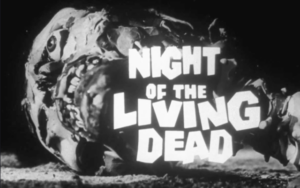HALLOWEEN CREEPTACULAR OCT 28! John Russo on “Night of the Living Dead”
 Without Night of the Living Dead movies like 28 Days Later, Shawn of the Dead or even Zombie Strippers wouldn’t exist. In 1968 the story of story of people trapped in a rural Pennsylvania farmhouse trying to survive an attack by reanimated ghouls dragged a bloody new horror genre into the marketplace. For better (see Re-Animator) and for worse (see Zombie Nightmare) the movie Rex Reed called “a classic” has spawned four decades of brain eating and head explosions, but according to the film’s co-author John Russo the origin of the idea was anything but sinister.
Without Night of the Living Dead movies like 28 Days Later, Shawn of the Dead or even Zombie Strippers wouldn’t exist. In 1968 the story of story of people trapped in a rural Pennsylvania farmhouse trying to survive an attack by reanimated ghouls dragged a bloody new horror genre into the marketplace. For better (see Re-Animator) and for worse (see Zombie Nightmare) the movie Rex Reed called “a classic” has spawned four decades of brain eating and head explosions, but according to the film’s co-author John Russo the origin of the idea was anything but sinister.
“Sometime in the winter of 1966 George Romero and I were having lunch with Richard Ricci,” says Russo, then a co-partner with Romero and Russell Streiner (who has the film’s most famous line, “They’re coming to get you, Barbara!”) in The Latent Image, a commercial television production house. “George and I were complaining about the fickleness of our commercial clients who, when they had not too much money to spend, would come to us for a good, creative job on their spots and sales films, and would promise to come back to us next time, when they would have more money to spend. But when they got more money they’d run away to the supposed glitz and glamour of New York or Hollywood. Richard said, ‘So why don’t you do something about it?’ I thought about it and said, ‘We oughtta be able to make something better than the crap we see on Chiller Theater.’
“George right away got excited, slammed the table with his big hand, sending bottles and glasses flying, and yelled, ‘We’re gonna make a movie!’”
The two batted around several ideas. One, titled Monster Flick, was a horror comedy about teenage aliens, while another focused on flesh eating aliens. “But we quickly discovered that we could not afford all the necessary special effects,” he says, so the writing continued.
“We’d go to work late at night in separate offices, at separate typewriters,” says Russo. “I said right away that our story should start in a cemetery because folks found cemeteries spooky. I was working on a script that started in a cemetery and involved aliens coming to earth in search of human flesh. But George took a break at Christmas time and came back with half of a story that started in a cemetery, and was in essence what became the first half of Night of the Living Dead. There were all the proper twists and turns and a lot of excitement, but George never said who the attackers were or why they were attacking.
“I said, ‘I like this, George, but who are these attackers? You never say.’ And he said he didn’t know. So I said, ‘It seems to me they could be dead people. But why are they attacking? What are they after?’ Again, he said he didn’t know. So I said, ‘Why don’t we use my flesheating idea?’ And he agreed.
“So that’s how the modern flesheating zombies were born!”
The film, titled Night of the Flesheaters, was shot on a shoe string budget—Bosco Chocolate Syrup and pig’s intestines subbed for real blood and guts—in rural Pennsylvania between June and December 1967. Once finished, Russo and Romero had a hard time selling the movie because of its unflinching violence and gory special effects. The pair stuck to their guns, however, denying distributor after distributor who demanded cuts or a happy ending. Finally they found a company who would show the film uncensored but there was still a problem.
“There was already a movie called Flesheaters, and their attorney threatened us, so we had to come up with a different title,” says Russo. “George Romero decided on Night of Anubis, after the Egyptian god of the dead. This was a weak title, and when Continental Pictures got ready to distribute we changed it to Night of the Living Dead.”
The movie premiered on October 1, 1968 earning a rave from Roger Ebert and that other mark of success for a horror film, condemnation from fundamentalist Christian groups.
These days it doesn’t take a lot of braaaaaaaaaaaaaaaains to see the legacy of Night of the Living Dead. The ghoulish story is considered a classic, has spawned comedies like the box office hit Zombieland and serious television shows like The Walking Dead and was even selected by the Library of Congress for preservation in the National Film Registry as a film deemed “culturally, historically or aesthetically significant.”
“We were absolutely dedicated toward making a movie that was true to its premise and the motivations of its characters, from start to finish,” says Russo, adding, “[the movie] struck a primal chord in everybody, perhaps because of the atavistic memory of our species as easy prey for wild beasts, which we were for most of human history. We all carry the deep-seated fear of being devoured.”
